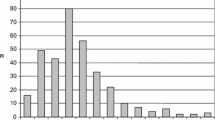Abstract
To assess the validity of tympanometry as a test for the presence of middle ear effusion using a ‘gold-standard’ of myringotomy performed after a nitrous oxide-free general anaesthetic, we performed a prospective validity study comparing tympanometry traces obtained immediately pre-operatively from patients undergoing grommet insertion, with the otomicroscopic findings at myringotomy. Nitrous oxide was omitted from the anaesthetic gaseous mixture as it has been reported to displace middle ear effusions. One hundred and seventy-two patients (aged 1.5–15 years) with a clinically assessed 3 month history of middle ear effusion were included in the study. Sensitivity and specificity of a Jerger classification Type B tympanometric trace for the presence of middle ear effusion were 0.73 and 0.84, respectively. We conclude that tympanometry is a valid test in assessing the presence of middle ear effusion compared to a ‘gold standard’ of myringotomy performed after a nitrous oxide-free general anaesthetic.
Similar content being viewed by others
References
Cantekin EI, Beery QC, Bluestone CD (1977) Tympanometric patterns found in middle ear effusions. Ann Otol Rhinol Laryngol Suppl 86(4 Pt 3 Suppl 41):16–20
Paradise JL, Smith CG, Bluestone CD (1976) Tympanometric detection of middle ear effusion in infants and young children. Pediatrics 58(2):198–210
Fiellau-Nikolajsen M (1980) Tympanometry and middle ear effusion: a cohort-study in three-year-old children. Int J Pediatr Otorhinolaryngol 2(1):39–49. doi:10.1016/0165-5876(80)90027-0
Gates GA, Avery C, Cooper JC, Hearne EM, Holt GR (1986) Predictive value of tympanometry in middle ear effusion. Ann Otol Rhinol Laryngol 95(1 Pt 1):46–50
Oyiborhoro JM, Olaniyan SO, Newman CW, Balakrishnan SL (1987) Efficacy of acoustic otoscope in detecting middle ear effusion in children. Laryngoscope 97(4):495–498. doi:10.1288/00005537-198704000-00016
Toner JG, Mains B (1990) Pneumatic otoscopy and tympanometry in the detection of middle ear effusion. Clin Otolaryngol Allied Sci 15(2):121–123. doi:10.1111/j.1365-2273.1990.tb00443.x
Finitzo T, Friel-Patti S, Chinn K, Brown O (1992) Tympanometry and otoscopy prior to myringotomy: issues in diagnosis of otitis media. Int J Pediatr Otorhinolaryngol 24(2):101–110. doi:10.1016/0165-5876(92)90136-D
Fields MJ, Allison RS, Corwin P, White PS, Doherty J (1993) Microtympanometry, microscopy and tympanometry in evaluating middle ear effusion prior to myringotomy. N Z Med J 106(963):386–387
Sassen ML van AA, Grote JJ (1994) Validity of tympanometry in the diagnosis of middle ear effusion. Clin Otolaryngol Allied Sci 19(3):185–189. doi:10.1111/j.1365-2273.1994.tb01211.x
Szucs E, Diependaele R, Clement PA (1995) The accuracy of tympanometry assessed by its sensitivity and specificity. Acta Otorhinolaryngol Belg 49(3):287–292
Watters GW, Jones JE, Freeland AP (1997) The predictive value of tympanometry in the diagnosis of middle ear effusion. Clin Otolaryngol Allied Sci 22(4):343–345. doi:10.1046/j.1365-2273.1997.00023.x
Palmu A, Puhakka H, Rahko T, Takala AK (1999) Diagnostic value of tympanometry in infants in clinical practice. Int J Pediatr Otorhinolaryngol 49(3):207–213. doi:10.1016/S0165-5876(99)00207-4
Harris PK, Hutchinson KM, Moravec J (2005) The use of tympanometry and pneumatic otoscopy for predicting middle ear disease. Am J Audiol 14(1):3–13. doi:10.1044/1059-0889(2005/002)
Koivunen P, Alho OP, Uhari M, Partanen A, Luotonen J (1996) General anesthesia with and without nitrous oxide (N2O) and the weight of middle ear effusion in children undergoing adenoidectomy and tympanostomy. Laryngoscope 106(6):724–726. doi:10.1097/00005537-199606000-00011
Davis I, Moore JR, Lahiri SK (1979) Nitrous oxide and the middle ear. Anaesthesia 34(2):147–151. doi:10.1111/j.1365-2044.1979.tb06269.x
Johnson LP, Parkin JL, Stevens MH, Otto WC, McCandless GA (1980) Action of general anesthesia on middle ear effusions. Arch Otolaryngol 106(2):100–102
Grimaldi PM (1976) The value of impedance testing in diagnosis of middle ear effusion. J Laryngol Otol 90(2):141–152. doi:10.1017/S0022215100081895
Jerger J (1970) Clinical experience with impedance audiometry. Arch Otolaryngol 92(4):311–324
Takata GS, Chan LS, Morphew T, Mangione-Smith R, Morton SC, Shekelle P (2003) Evidence assessment of the accuracy of methods of diagnosing middle ear effusion in children with otitis media with effusion. Pediatrics 112(6 Pt 1):1379–1387. doi:10.1542/peds.112.6.1379
Bluestone CD, Beery QC, Paradise JL (1973) Audiometry and tympanometry in relation to middle ear effusions in children. Laryngoscope 83(4):594–604. doi:10.1288/00005537-197304000-00015
Thomsen KA, Terkildsen K, Arnfred I (1965) Middle ear pressure variations during anesthesia. Arch Otolaryngol 82(6):609–611
Singh CB, Kirk R (1979) The effect of nitrous oxide on middle ear pressure in children during anaesthesia. J Laryngol Otol 93(4):349–356. doi:10.1017/S0022215100087120
Tympanometry OE (2004) Am Fam Physician 70(9):1713–1720
Rees GL, Freeland AP (1992) The effect of anaesthesia on tympanograms of children undergoing grommet insertion. Clin Otolaryngol Allied Sci 17(3):200–202. doi:10.1111/j.1365-2273.1992.tb01826.x
Margolis RH, Hunter LL (1999) Tympanometry: basic prinicples and clinical applications. In: Musiek FE, Rintelmann WF (eds) Contemporary perspectives in hearing assessment. Allyn and Bacon, Boston, pp 89–130
Acknowledgements
We acknowledge the contribution of the Day Surgery staff at Princess Royal University Hospital for facilitating the trial. We would also like to acknowledge Marika Humphrey, Chief Audiologist at Princess Royal University Hospital, for providing the tympanometry equipment for this trial.
Author information
Authors and Affiliations
Corresponding author
Rights and permissions
About this article
Cite this article
Fishpool, S.J.C., Kuhanendran, D., Swaminathan, D. et al. An assessment of the validity of tympanometry compared to myringotomy performed under a nitrous oxide-free general anaesthetic. Eur Arch Otorhinolaryngol 266, 373–376 (2009). https://doi.org/10.1007/s00405-008-0765-y
Received:
Accepted:
Published:
Issue Date:
DOI: https://doi.org/10.1007/s00405-008-0765-y




